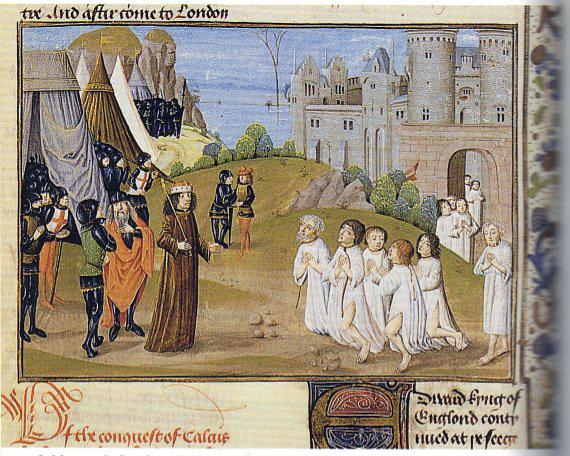About the Artist
Auguste Rodin
Born: Paris, 12 November 1840
Died: Meudon, 18 November 1917
Nationality: French

Fig 13.9
Collection
Calais, France
Documentation:
Contemporary German author Rainer Maria Rilke wrote:
“And withal the single figures did not touch one another, they stood side by side, like the last remaining trees of a forest which had been felled, and the only thing uniting them was the air, which bore a quite peculiar relationship to them. Passing round the group, one was amazed to see how the gestures rose pure and great from out the rhythm of the contours, how they rose, stood still and fell back into the mass, like flags being furled. Everything was clear and definite. There appeared to be no room for accident of any kind. Like all Rodin’s groups, this one was self-contained, a world within itself, a whole, filled with life which circulated within it and nowhere passed outside or lost itself. In place of contacts we have here the overlapping of contours, which is, indeed, a kind of contact, immensely reduced through the medium of the intervening air which acts upon and modifies them. There are contacts with distance between, meeting-points, the passing of one form in front of another, such as are seen at times in masses of clouds or amongst mountains, where the air is not a dividing abyss but rather a gradual transition, suggestive of direction.
The participation of the atmosphere had always been an important factor for Rodin, He had made all his things, plane for plane, in relationship to space, and this gave them that greatness and independence, that indescribable maturity, which distinguished them from all other works. But now, having gradually learnt, in his interpretation of nature, to emphasize expression, it appeared that, in doing so, he had also intensified the relationship of the atmosphere to his statue, so that it surrounded the interdependent planes more vividly, as it were, more passionately. Whereas formerly his works stood in the midst of space, it now seemed as if space snatched them to itself.”
Rainer Maria Rilke, “The Rodin-Book: First Part” (1902) in Rodin and Other Prose Pieces, G. Craig Houston, trans. (London: Quartet Books, 1986), 39.
Web Resources:
Same Subject by Other Artists:
Jean-Simon Berthélemy, Burghers of Calais, 1782 (Musée des Beaux-Arts, Béziers)
Benjamin West, Burghers of Calais, 1788 (Detroit Institute of Art)
Ary Scheffer, The Patriotic Surrender of the Six Burghers of Calais in 1342, 1819 (Musée de l'Histoire de France, Versailles)
Images
In an anticipation of cinematic motion (a decade away), viewers must circumambulate the Burghers in order to see it all.
Rodin considered evidence of process an important part of visual experience. This is one of his modernist innovations.
Eustache de Saint-Pierre was the oldest Burgher. Rodin revealied differing psychological states in face and body expression.
Jean de Fiennes was the youngest Burgher. His hair does not imitate strands, but shows the clay modeling process.
In an anticipation of cinematic motion (a decade away), viewers must circumambulate the Burghers in order to see it all.
Rodin left the marks of the tools he used to make the clay original. Legibility of such detail indicates a good bronze cast.








